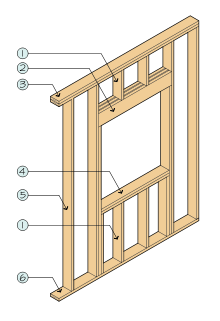Loading AI tools
Component of a building's wall From Wikipedia, the free encyclopedia
Wall studs are framing components in timber or steel-framed walls, that run between the top and bottom plates. It is a fundamental element in frame building. The majority non-masonry buildings rely on wall studs, with wood being the most common and least-expensive material used for studs. Studs are positioned perpendicular to the wall they’re forming to give strength and create space for wires, pipes and insulation. Studs are sandwiched between two horizontal boards called top and bottom plates. These boards are nailed or screwed to the top and bottom ends of the studs, forming the complete wall frame. Studs are usually spaced 16 in. or 24 in. apart.[1]
This article needs additional citations for verification. (May 2009) |

Stud is an ancient word related to similar words in Old English, Old Norse, Middle High German, and Old Teutonic generally meaning prop or support.[2] Other historical words with similar meaning are quarter[2] and scantling[1] (one sense meaning a smaller timber, not necessarily the same use). Stick is a colloquial term for both framing lumber (timber) and a "timber tree"[3] (a tree trunk good for using as lumber (timber)); thus, the names "stick and platform", "stick and frame", "stick and box", or simply stick framing. The stud height usually determines the ceiling height, thus sayings like: "...These rooms were usually high in stud..."[2]
Studs form walls and may carry vertical structural loads or be non load-bearing, such as in partition walls, which only separate spaces. They hold in place the windows, doors, interior finish, exterior sheathing or siding, insulation and utilities and help give shape to a building. Studs run from sill plate to wall plate. In modern construction, studs are anchored to the plates in a way, such as using fasteners, to prevent the building from being lifted off the foundation by severe wind or earthquake.
Studs are usually slender, so more studs are needed than in post and beam framing. Sometimes studs are long, as in balloon framing, where the studs extend two stories and carry a ledger which carries joists. Balloon framing has been made illegal in new construction in many jurisdictions for fire safety reasons because the open wall cavities allow fire to quickly spread such as from a basement to an attic; the plates and platforms in platform framing provide a passive fire stop inside the walls, and so are deemed much safer by fire safety officials. Being thinner and lighter, stick construction techniques are easier to cut and carry and is speedier than the timber framing.
In the United States and Canada, studs are traditionally made of wood, usually 2×4 or 2×6 by name; however, these historical dimensions have been reduced but still carry the name of "two by four" and "two by six". Typical dimensions of today's "two by four" is 1.5 by 3.5 inches (38 mm × 89 mm) dimensional lumber prior to sanding and are typically placed 16 inches (406 mm) from each other's center, but sometimes also at 12 inches (305 mm) or 24 inches (610 mm). The wood needs to be dry when used, or problems may occur as the studs shrink and twist as they dry out. Steel studs are gaining popularity as a non-combustible alternative, especially for non load-bearing walls, and are required in some firewalls.
In New Zealand, the required lumber size and spacing of wall studs are determined using NZS 3604 Timber-framed buildings table 8.2 for loadbearing walls and table 8.4 for non-loadbearing walls.[4]
The studs used to frame around window and door openings are sometimes given different names, including:
A building technique mostly associated with Lincolnshire, England, and parts of Scotland gets part of its name from the studs: mud and stud (stud and mud). This building method uses studs in a framework which is then totally covered with mud which resembles the building material cob.[5] Another traditional building method is called stud and plaster where the plaster walls are held by lath on the studs. Studs are also the namesake of a type of timber framing called close studding.
Based on the American West Coast Lumber Inspection Bureau (WCLIB) grading rules,[6] there is only one grade of stud: STUD. A stud is graded for vertical application and its stress requirements and allowable visual defects reflect that application. A stud is most similar to a #2 grade, which is held to a higher standard during grading. The biggest difference between the two is the frequency, placement and size of knots and overall allowable wane.
Seamless Wikipedia browsing. On steroids.
Every time you click a link to Wikipedia, Wiktionary or Wikiquote in your browser's search results, it will show the modern Wikiwand interface.
Wikiwand extension is a five stars, simple, with minimum permission required to keep your browsing private, safe and transparent.